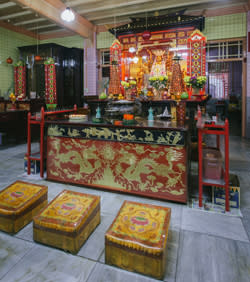Once bitten, vice shy
The room is choked with cigarette smoke and middle-aged men slamming mahjong tiles on tables. I’m on the second floor of a Keong Saik Road shophouse, and the moment I peek my head in, three of them silently approach me. Brusquely, they tell me they won’t be able to help with this story. Maybe some ghosts of Bukit Pasoh’s past still linger on.
The Bukit Pasoh Conservation Area is ringed by New Bridge Road to the north, Neil Road to the south, and Cantonment Road and Kreta Ayer Road on its sides. Keong Saik Road is the district’s main artery, vertically slicing the area in two. Bukit Pasoh is one of those ageing estates with rows upon rows of shophouses designed in the Art Deco and Peranakan styles, a neighbourhood whose sleepiness belies its colourful history: During Singapore’s early colonial period, it was first a nutmeg plantation and then a residential hub, before gaining its seedy and dangerous reputation in the 1960s.
But that has all changed. On 7 July 1989, the Urban Redevelopment Authority of Singapore designated Bukit Pasoh and its outlying streets as a conservation area. More than 200 buildings have been conserved. After a flurry of redevelopment in the 1990s, boutique hotels started cropping up alongside old-school kopitiams and Chinese clan associations. Now, the area is home to swanky restaurants and cafés that are on the lips of every savvy local. But before swooning over these modern venues, we take a look at the unchanged faces of Bukit Pasoh.
The old guard
At the corner of Keong Saik Road and Teck Lim Road, a three-storey, flat iron-shaped building marshals a long line of salty ah cheks and skinny-jeaned hipsters alike.Tong Ah Eating House has been in business since 1939, and is known for its homemade kaya and fragrant kopi. “The shop is not just famous in Singapore—all over the world, also!” fourth-generation owner Tang Chew Fue tells me while deftly flipping slices of pillowy white bread over a grill.
Chew Fue is one of the old guard, the resilient folk who stuck around Bukit Pasoh in spite of its notoriety and subsequent gentrification. His family’s coffee shop is now an emblem of the area, shot to fame after being featured in a New York Times article about local coffee. “Business still carries on, lah. The government has improved the area; it’s a lot more hygienic now,” he says before letting out a sigh, “but ah, I think I still prefer the old ways.”
Maybe not all of them. Half a century ago, the neighbourhood was a haven for vice, with brothels, secret society hangouts — it was the turf of the infamous Sio Loh Kuan gang — and gambling dens flanking Keong Saik Road. Bukit Pasoh Road itself was even given the ignoble nickname “Mistress Street,” a jab at the gaggle of kept women who used to wait for their towkay lovers
Right at home
Just up the road from Tong Ah, a temple dedicated to the Buddhist goddess Guanyin has stood almost unchanged since 1928. Despite its age, or perhaps because of it, the Kong Tee Peng temple is still the most striking building on the street, never mind the über-hip joints that have sprung up, weed-like, beside it. Deep circular windows, intricately decorated tiles and an orange-and-cream façade aren’t so much relics of the past as they are proud reminders of it. Why bother with a funky mural when Peranakan architecture is timeless as it is?




